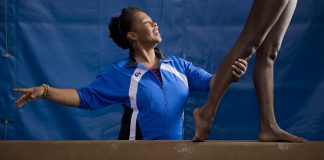The Animated Sports Hall of Fame recognizes animated athletes who best demonstrate sport and sportsmanship. These characters have woven themselves into the culture of their sport. We honour their achievements with a thorough breakdown of how their personality encompasses the sport they represent. The first inductee into the Animated Sports Hall of Fame is Disney’s Goofy.
You think Bo Jackson played a lot of sports? Goofy plays all of them: basketball, hockey, golf, boxing, sailing, football, and tennis. He’s a real man’s man, or rather, a real man’s man’s best friend. The anthropomorphic dog is used as Disney’s comic relief, getting tossed around and slapped silly. He’s dim-witted, clumsy, and completely incompetent in anything he does. So why would Disney make this klutz an athlete?
In the 1940s, Walt Disney’s classic trio of Mickey Mouse and his two best friends, Donald Duck and Goofy, split. While Mickey starred in his iconic Fantasia role, and Donald served in World War II propaganda films, Goofy had to deal with another breakup. His voice actor, Pinto Colvig, had left the studio. Therefore, Disney aimed to use Goofy in a role that didn’t require him to speak, deciding on a series of how-to educational videos.
Animation veteran Jack Kinney was tasked to direct the shorts, armed with members of Disney’s Nine Old Men, Disney’s team of master animators. The films featured a narrator explaining the rules and aims of the sport with gags of Goofy’s inadequacies in performing those instructions. Putting on skis turns him into a pretzel. A spitball spits in his face, and he can’t play a hole of golf without a bull chasing him. Even though he’s making a “goof” of himself and experiencing physical pain at the level of Homer Simpson, he stays hopeful, optimistic, and eager to learn more.
The first film, 1941’s The Art of Skiing, shows Goofy learning the different forms of skiing. The infamous “Goofy holler” makes its debut as Goofy ski jumps, soaring through the clouds before crashing into his bed, “falling asleep.” The second film, The Art of Self Defense, demonstrates “manly arts” throughout history and how they gave rise to modern sport. The narrator explains that an athlete is “the combination of science and skill, the personification of brain over brawn.” Then Goofy walks in. Goofy takes a beating as he learns how to box; even his shadow hammers him. Finally, he enters the ring, confident and fearless, only to be knocked out by running into a punch.
Anything Goofy attempted he failed miserably. If the conflict is Goofy versus Nature, the law is Goofy loses.
In 1942, Walt Disney was commissioned to produce a baseball short to feature with The Pride of the Yankees, the biographical film about Lou Gehrig, who had passed away one year earlier. The short, How to Play Baseball, started the trend of Goofy appearing as every character. Now it wasn’t just Goofy versus Nature, but Goofy versus Goofy, and the mayhem multiplied. Spending so much time with one character allowed the animators to push Goofy’s dimensions and test how far he’d stretch and how hard he’d fall, balancing amazing flexibility with believable weight. The film was a commercial success and continued the American pride in a country that had not only lost a national hero in Gehrig, but had recently entered the war.
Pinto Colvig returned to voice Goofy in a series of How to… cartoons in which goofy learned swimming, fishing, sailing, golf, hockey, and gymnastics. In each short the animation is smooth, the energy is high and Goofy takes a whoopin’. Even when Goofy won, it was accomplished by error and accompanied with misfortune.
“This isn’t flying. It’s falling, with style.” – Buzz Lightyear
The pinnacle of the How to… cartoons was 1944’s How to Play Football, in which two teams of Goofys compete in a game of college football.
It’s some of the best physical comedy in the Disney canon and is considered to be the best Goofy short. The film scored Goofy his first Academy Award nomination, but he lost again, this time to Tom and Jerry.
Afterwards, Goofy played basketball, tennis, hunted fowls and rhinos, and raced horses. By this point Goofy had lost several features including his stubble, droopy ears, and tiny hat. On Disney’s direction, Goofy became an everyman who dealt with issues of 1950s culture such as dieting, quitting smoking, and raising a family. His zaniness gave way to realism, something Disney hoped would make Goofy resonate with audiences, but instead, his popularity faded. Goofy’s Freeway Troubles (1965) was the last Goofy short before Walt Disney’s death in 1966. Colvig died from lung cancer in 1967, and the character disappeared.
The Goofy short was resurrected in 1987’s Sport Goofy in Soccermania, an NBC television special. In what became the pilot for the show DuckTales, Goofy teams up with Scrooge McDuck and his grandnephews, Huey, Dewey, and Louie, for a soccer match. But strangely, Goofy is…good. He’s such a good soccer player Scrooge recruits him, and the rival team kidnaps him to keep him from the game, only for Goofy to escape and return at halftime to win the championship. Goofy had finally won. Talk about a late bloomer.
In Goofy’s last short before his retirement, 2007’s How to Hook up Your Home Theatre, he learns how to install a home theatre system. Why? To watch sports, of course.
Goofy’s love of sport made him an all-American athlete and a silver screen star. But Goofy belongs in the Animated Sports Hall of Fame because he shows us the side of the athlete we don’t see: their study, their pain, their perseverance. No one gets knocked down and gets up again like Goofy. He takes it like a champ.
“I’ve failed over and over again… and that is why I succeed.” – Michael Jordan













